Fisher’s Fiducial Inference for Parameters of Uniform Distribution ()
1. Introduction
In 1930 Fisher proposed an inference method based on the idea of fiducial probability [1,2]. Fisher’s fiducial inference has been much applied in practice. The fiducial argument stands out somewhat of an enigma in classical statistics. The enigma mentioned above need statistical scholar to solve.
Fisher’s fiducial inference for the parameters of a totality  is discussed. The corresponding fiducial distributions are derived. The maximum fiducial estimators, the fiducial median estimators and the fiducial expect estimators of
is discussed. The corresponding fiducial distributions are derived. The maximum fiducial estimators, the fiducial median estimators and the fiducial expect estimators of  and
and  are got. The problems about the fiducial interval, fiducial region and hypothesis testing are discussed.
are got. The problems about the fiducial interval, fiducial region and hypothesis testing are discussed.
The example below shows that Neyman-Pearson’s confidence interval has some place to be improved. Let  be i.i.d.,
be i.i.d.,  for each j.
for each j. . By [3] p. 16 Corollary 3.2 the density function of
. By [3] p. 16 Corollary 3.2 the density function of  is
is

Appling pivotal function

And using its density

the 95% confidence interval of  can be got as
can be got as
 (*)
(*)
where  is the solution of
is the solution of

The length of interval (*) is independent of the sample value! Assam that

Is got in a certain sample (Note that
 the above data can illustrate the common problems). The probability that
the above data can illustrate the common problems). The probability that

i.e. , is 1, the length of it is 0.19, but the length of (*) is
, is 1, the length of it is 0.19, but the length of (*) is 
Fisher’s fiducial inference offered a selection in solving the problems similar with above.
2. Fiducial Distribution
Let that  is i.i.d.,
is i.i.d.,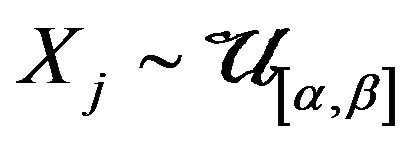 . As well known, their sufficient statistics of least dimension is
. As well known, their sufficient statistics of least dimension is .Set
.Set
 (2.1)
(2.1)
It is not difficult to show that Y and Z are the minimum and maximum order statistics of the sample from 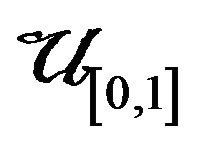 respectively, and by [3] p. 16 Corollary 3.2, the density function of
respectively, and by [3] p. 16 Corollary 3.2, the density function of  is
is
 (2.2)
(2.2)
See parameters  and
and  as r.v.’s, see
as r.v.’s, see  and
and 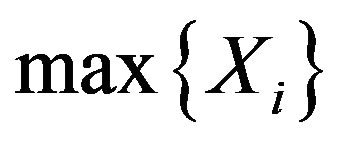 as constants now. It can be got from Equation (2.1) that
as constants now. It can be got from Equation (2.1) that
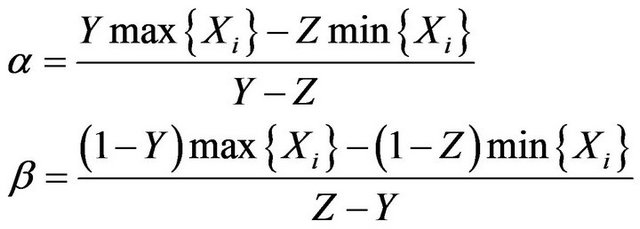 (2.3)
(2.3)
Applying the relative results about the transformation of r.v.’s, it can be show that:
Theorem 1. The fiducial density function of vector 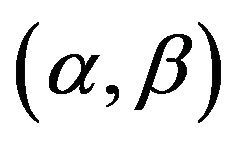 is
is
 (2.4)
(2.4)
If only one parameter need to be considered, the another parameter is then so-called nuisance parameter. We insist that the marginal distribution should be used in this situation. Hence find the two marginal density functions of 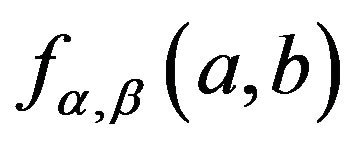
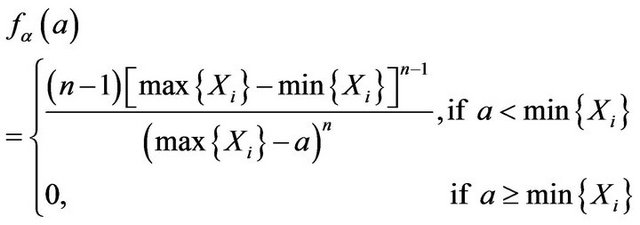 (2.5)
(2.5)
 (2.6)
(2.6)
Corollary 1. The fiducial density functions of only one parameters  or
or  as r.v.’s are given by (2.5) and (2.6).
as r.v.’s are given by (2.5) and (2.6).
3. Estimation
It is easy to see that fiducial density 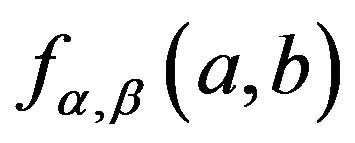 has achieved its maxima at
has achieved its maxima at
 (3.1)
(3.1)
 (3.2)
(3.2)
Theorem 2. The maximum fiducial estimators of  and
and  are given by (3.1) and (3.2).
are given by (3.1) and (3.2).
It can also be got that 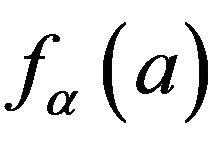 has achieved its maxima at
has achieved its maxima at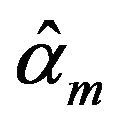 , and
, and  has achieved its maxima at
has achieved its maxima at  as well. The estimators
as well. The estimators 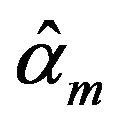 and
and  are coincided with the maximum likelihood estimators of
are coincided with the maximum likelihood estimators of  and
and .
.
To find the median of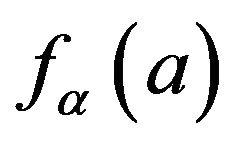 , solve
, solve
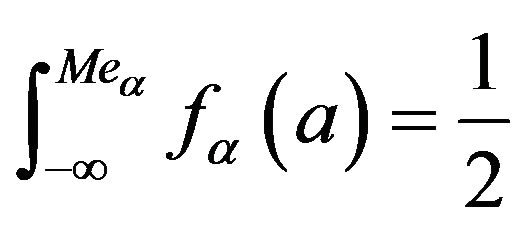 (3.3)
(3.3)
And get
 (3.4)
(3.4)
Found the median of  by using the same method, and have
by using the same method, and have
 (3.5)
(3.5)
Theorem 3. The fiducial median estimators of  and
and  are given by (3.4) and (3.5).
are given by (3.4) and (3.5).
The maximum fiducial estimators  and
and 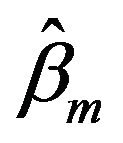 are extreme a little, Equation (3.1) can be written as
are extreme a little, Equation (3.1) can be written as

Since

 is a modify to
is a modify to , and
, and 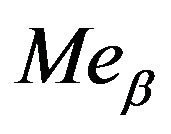 is a modify to
is a modify to 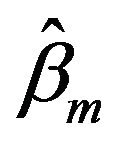 too.
too.
It can be shown that:
Theorem 4. The fiducial expect estimators of  and
and  are given by
are given by
 (3.6)
(3.6)
wang#title3_4:spProof.

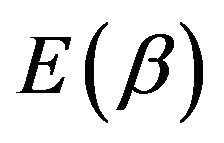 can be calculated by using the same method. □
can be calculated by using the same method. □
 is a better modify to
is a better modify to , and
, and 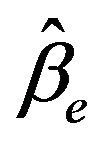 is a better modify to
is a better modify to 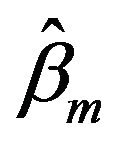 as well. We suggest using
as well. We suggest using  and
and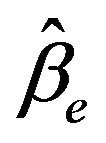 .
.
The fiducial probability that  belongs to a certain interval estimator
belongs to a certain interval estimator  can be calculated using
can be calculated using 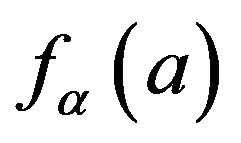 as follows
as follows
 (3.7)
(3.7)
In the same way
 (3.8)
(3.8)
Give a fiducial probability  let us consider the
let us consider the  fiducial interval problem. In order to set the length of the interval as shorter as possible, we choice
fiducial interval problem. In order to set the length of the interval as shorter as possible, we choice 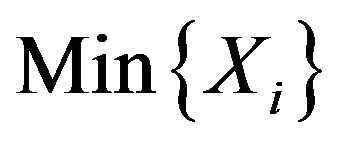 as the right end point of the fiducial interval of
as the right end point of the fiducial interval of , because
, because 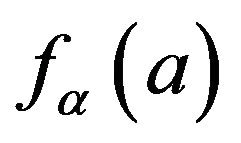 increases; and choice
increases; and choice  as the left end point of the fiducial interval of
as the left end point of the fiducial interval of , because
, because  decreases.
decreases.
Theorem 5. The  fiducial interval of
fiducial interval of  is
is
 (3.9)
(3.9)
The 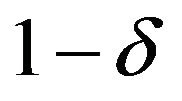 fiducial interval of
fiducial interval of  is
is
 (3.10)
(3.10)
Proof. Denote that

Using (3.7) it can be derived that

And the bellow equation can be got by using (3.8)
 □
□
Let us consider the  fiducial region of
fiducial region of . In order to set the area of the region as smaller as possible, we choice the region as the following rectangular triangle:
. In order to set the area of the region as smaller as possible, we choice the region as the following rectangular triangle:
 (3.11)
(3.11)
for a certain d > 0, because  choice the same value when
choice the same value when  equals to a constant, and
equals to a constant, and  increases in a when b is invariant, decreases in b when a is invariant.
increases in a when b is invariant, decreases in b when a is invariant.
Theorem 6. The 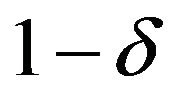 fiducial region of
fiducial region of  is given by (3.11) if positive d satisfies
is given by (3.11) if positive d satisfies
 (3.12)
(3.12)
Proof. At first Equation (3.12) has a positive solution d because its left side equal to 1 when  and tends to 0 when d tends to
and tends to 0 when d tends to . Hence the fiducial probability that
. Hence the fiducial probability that  belongs to the region given by (3.11) is
belongs to the region given by (3.11) is
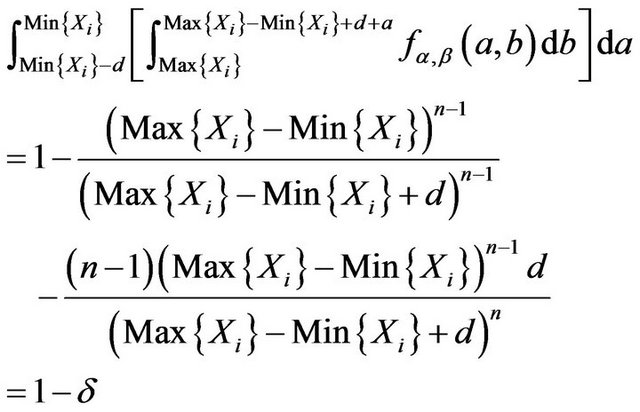
Equation (3.12) is used here. □
4. The Case That One Parameter Is in Variation
Let us consider the case that only one parameter is in variation.
 is a distribution with single-parameter when one end point of
is a distribution with single-parameter when one end point of 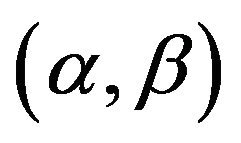 is constant. For constant b0
is constant. For constant b0
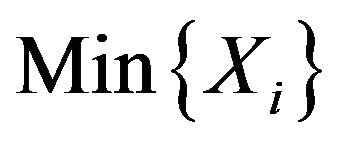 is sufficient for
is sufficient for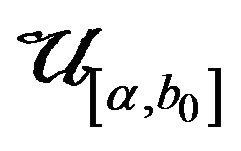 . It can be got that the fiducial density of parameter
. It can be got that the fiducial density of parameter  in
in  is
is
 (4.1)
(4.1)
It should noted that using (2.4) and (2.6) the conditional density of  under
under 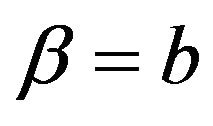 can be got as
can be got as
 (4.2)
(4.2)
Comparing (4.1) and (4.2) is to say that (4.1) is coincided with the conditional density of  under
under 
The maximum fiducial estimators, the fiducial median estimators and the fiducial expect estimators of  can be got easily by using (4.1).
can be got easily by using (4.1).
The fiducial probability of one interval estimator  for
for  can be calculated as
can be calculated as
 (4.3)
(4.3)
The  fiducial interval of
fiducial interval of  can be got as follows by using (4.3).
can be got as follows by using (4.3).
 (4.4)
(4.4)
The similar results for  can be got easily as well.
can be got easily as well.
If there is a relation between the parameters, such as the example in Section 1, this situation may be thought as missing parameter(s). We insist that the conditional distribution should be used in this situation. Under the condition that  for a constant C, the conditional density
for a constant C, the conditional density , or
, or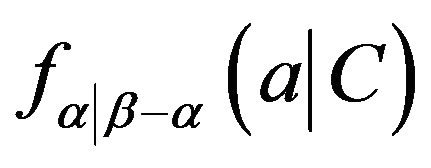 , is a constant in the interval on which its value isn’t zero, because
, is a constant in the interval on which its value isn’t zero, because  is a constant when
is a constant when . Since
. Since

 the conditional density
the conditional density  is the density of
is the density of
 . This is the fiducial density of the parameter
. This is the fiducial density of the parameter  of a totality
of a totality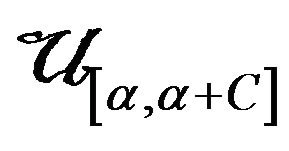 .
.
It can be seen that for distribution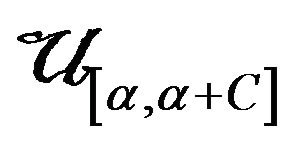 ,
,

is a 100% fiducial interval of . Any subinterval of
. Any subinterval of

is a  fiducial interval of
fiducial interval of  in this problem only if it has the length
in this problem only if it has the length
 .
.
Using the above results to the example in Section 1 it can be got that any subinterval of [0.89, 1.08] with the length 0.95 × 0.19 is the 95% fiducial interval of . Its length 0.1805 is much smaller than
. Its length 0.1805 is much smaller than , the length of interval (*).
, the length of interval (*).
5. Hypothesis Testing
Let us consider the hypothesis testing problem. Equation (3.7) and (3.8) can be used to calculate the fiducial probability when the parameter would belong to the range that a certain hypothesis is true.
Theorem 7. For hypothesis
 (5.1)
(5.1)
And should rejected H1 w.p.1 if .
.
Proof. Choice  and
and  in (3.7). □
in (3.7). □
If for a certain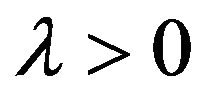 , the decision is made by comparing
, the decision is made by comparing  with
with , then the criterion is that reject H0 when
, then the criterion is that reject H0 when
 (5.2)
(5.2)
Note that the left hand of (5.2) is the quantile of order
 of the fiducial distribution of
of the fiducial distribution of . Especially for
. Especially for
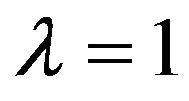 the criterion is reject H0 when
the criterion is reject H0 when
 (5.3)
(5.3)
Theorem 8. For hypothesis

The fiducial probability
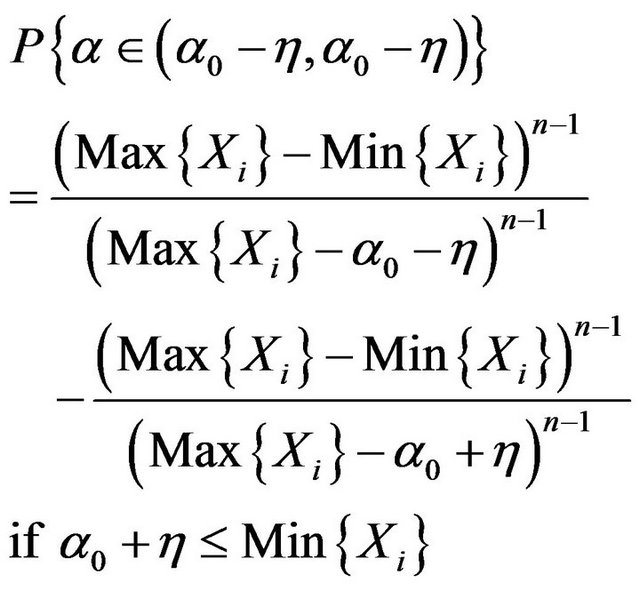
Proof. The result can be got just like theorem 7. □
The parallel results for  can be got by using the same method as well.
can be got by using the same method as well.
Theorem 9. Hypothesis

The fiducial probability
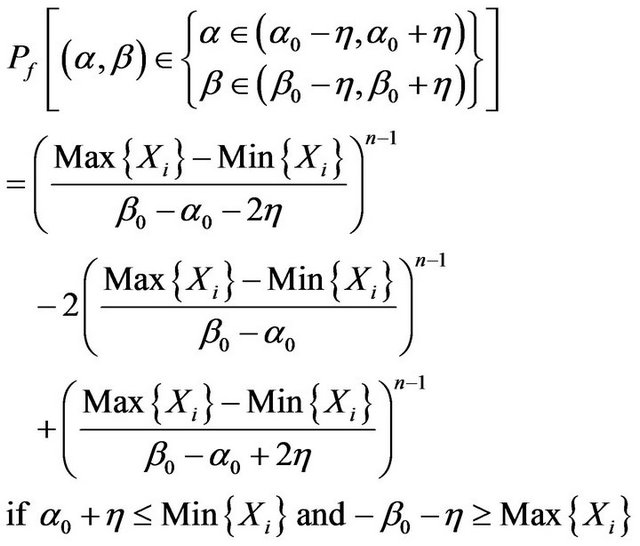
wang#title3_4:spProof.
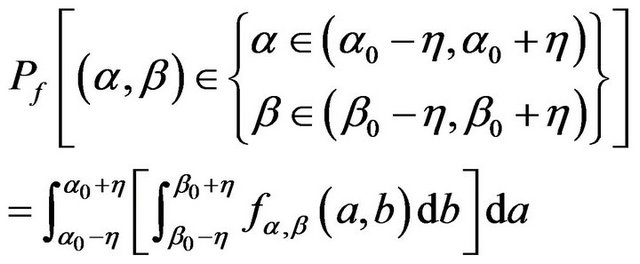
This theorem can be got by calculating the above integral. □
The fiducial probability in the situation that the parameters would belong to the range that a certain hypothesis in Theorem 7 or 8 is true can be easily got by using (4.3) in the case that one parameter is in variation.
Example. For the example in Section 1, consider the hypothesis

It can be shown that

If for a certain , the decision is made by comparing
, the decision is made by comparing  with
with , when the one in front is greater,
, when the one in front is greater,
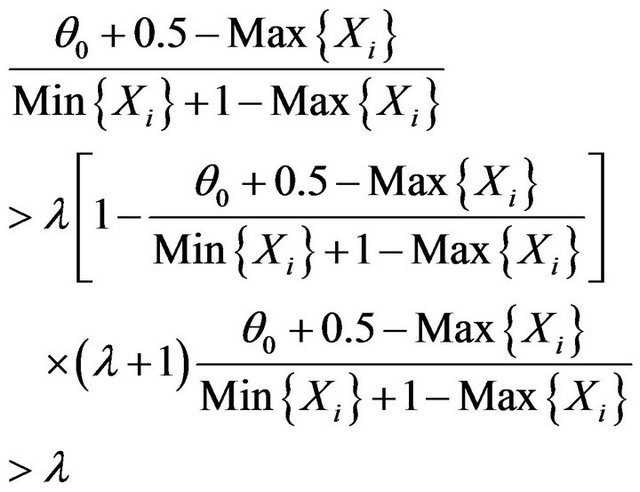
So the criterion is that reject H0 when
 (5.4)
(5.4)
Please note that the left hand of (5.4) is the quantile of order  of the fiducial distribution of
of the fiducial distribution of . Especially for
. Especially for  the criterion is that reject H0 when
the criterion is that reject H0 when
 (5.5)
(5.5)
That is
 (5.6)
(5.6)
6. Discussion
Up to now, the discussion on Fisher’s fiducial inference has still remained intuitive and imprecise. There are two problems: 1) Just what a fiducial probability means? 2) How can one derive the only fiducial distribution of the parameter(s)? Paper [4] considered the 1st problem. For the 2nd problem we guess that two sufficient statistics of least dimension, whose dimension is coincides with the parameter(s), must derive the same fiducial distribution of the parameter(s). And we insist that the marginal distribution should be used in the situation when there is (are) nuisance parameter(s); and that the conditional distribution should be used in the situation when there is (are) (a) relation(s) between the parameters.